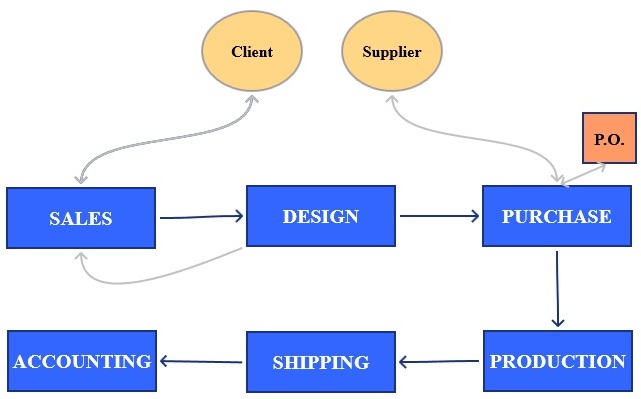Typically, from sales to the shipment of the product or the after-sale service.
What is a business process?
A business process diagram is a model that will illustrate the step-by-step process a company uses to produce a good or a service. In the business process diagram, you want to illustrate 3 things:
- The actions taken: meet client, design a prototype, ship the product, etc.
- The actors involved: employees, clients, suppliers, etc.
- The documents produced: purchase order, invoices, etc.
Build your diagram department by department and start and the beginning of the process, typically sales.
Step One – Create the general business process mapping
The first thing you want to do is to create the general business process. This step should be pretty obvious and should take less than a day.

- Start creating the general process, department by department, from beginning to the end. Sales send the project to the design, which sends it to production, etc.
- Draw all links between department. In the example above, the sales department sends its information about the new project to the design department. Once the design is done, they send it back to the sales department to show to the client.
- Include the interactions with clients, suppliers and other actors.
- Add to the drawing the important documents needed or created. Since we will do this in the next step as well, It may be easier to come back to this one once the detailed process is done.
Step Two – Create the process for each department
Now that the general business process is created, do the same thing, but for each department. This time, the process has to be documented in greater details.
There are two ways of doing a business process mapping: a short version and a detailed version. In both versions, you need to assess the general process of each department, but in the detailed one, you’ll go into much greater details, assessing each and every little step each employee does.
Sales department’s example
Let’s take the example of a sales department. The business process of the sales representative should look like:
Business process example – Short version

Business process example – Detailed version

You see that those two business processes are the same, except that the second one has much more details. But why would you need to go into such details? A lot of information can be extracted from such processes.
In our example, what we gain from the detailed version are:
- we learn that we need a module that will register calls to clients, that will allow reminders on clients’ files and a module that will manage the reps meetings (steps 2, 3 & 5)
- we learn that we could use a module that will register travels from our reps for accounting purposes (step 6)
- on step 8, we can deduce that having a function that would allow us to enter meetings’ briefings could be useful
So, by doing a detailed process mapping, you make sure that all the requirements for the future ERP are documented. Another advantage is that you can deduct all the essential reports needed for that department just by looking at the process.
How do you know which version to use?
The general idea when doing a business process mapping is to use the detailed version as much as possible to reduce the risks (of error, of forgetting a module, etc.). But since it is a long task, not every company will have the time and budget to do it for their entire process.
The general rule of thumb is at the minimum, use the detailed process mapping for your core business and use the short version for the remaining of the company’ process.
The detailed analysis should also be done in the following cases:
- the company’s process – or part of – is complicated
- the main objective is to gain a competitive advantage with the ERP implementation
- the business process has never been assessed
- the analyzed department/process is your core business
Next step: Business process optimization
Home > ERP Implementation Project > Business Analysis > Process Mapping
